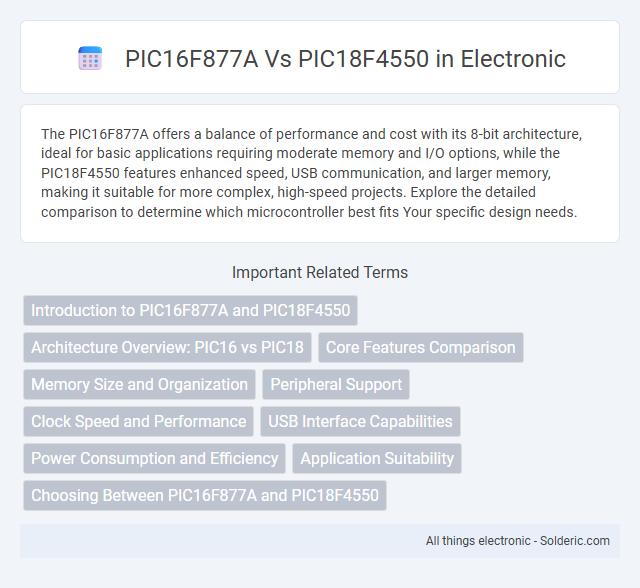The PIC16F877A offers a balance of performance and cost with its 8-bit architecture, ideal for basic applications requiring moderate memory and I/O options, while the PIC18F4550 features enhanced speed, USB communication, and larger memory, making it suitable for more complex, high-speed projects. Explore the detailed comparison to determine which microcontroller best fits Your specific design needs.
Comparison Table
| Feature | PIC16F877A | PIC18F4550 |
|---|---|---|
| Architecture | 8-bit Mid-Range MCU | 8-bit High-Performance MCU |
| Operating Voltage | 2.0V - 5.5V | 2.0V - 5.5V |
| Program Memory (Flash) | 14 KB | 32 KB |
| RAM | 368 Bytes | 2 KB |
| EEPROM | 256 Bytes | 256 Bytes |
| CPU Speed | 20 MHz | 48 MHz |
| USB Support | No | Yes (Full-Speed USB 2.0) |
| ADC Channels | 8 Channels, 10-bit | 13 Channels, 10-bit |
| Timers | 3 (8/16-bit) | 4 (8/16-bit) |
| USART | Yes | Yes |
| SPI | Yes | Yes |
| I2C | Yes | Yes |
| Package | 40-pin DIP, QFP, PLCC | 40-pin DIP, TQFP |
| Applications | General embedded systems, basic control | USB devices, complex embedded systems |
Introduction to PIC16F877A and PIC18F4550
PIC16F877A is an 8-bit microcontroller from Microchip's mid-range PIC16 family, featuring 368 bytes of RAM, 14-bit instruction words, and up to 40 MHz clock speed, well-suited for basic embedded applications. PIC18F4550 belongs to the high-performance PIC18 series, offering enhanced features like 32 KB flash memory, USB 2.0 support, 2 KB RAM, and a 12-bit ADC, ideal for complex and USB-powered devices. Both microcontrollers integrate versatile I/O ports and peripherals but target different application scales and processing capabilities.
Architecture Overview: PIC16 vs PIC18
The PIC16F877A features a 14-bit Harvard architecture with a RISC CPU optimized for low-power applications, supporting up to 8KB of program memory and limited instruction complexity. In contrast, the PIC18F4550 utilizes a 16-bit architecture with enhanced interrupt handling, a richer instruction set, and advanced addressing modes, supporting up to 32KB of program memory. PIC18 devices like the PIC18F4550 are designed for more complex embedded applications requiring higher processing power and memory management compared to the mid-range PIC16 series exemplified by the PIC16F877A.
Core Features Comparison
The PIC16F877A features a 14-bit instruction set with 368 bytes of RAM and operates at up to 20 MHz, making it suitable for basic control applications. In contrast, the PIC18F4550 boasts a more advanced 16-bit instruction set, 2 KB of RAM, and runs at a higher speed of up to 48 MHz, providing enhanced performance for complex tasks. Your choice between these microcontrollers depends on the need for processing power, memory capacity, and peripheral support.
Memory Size and Organization
The PIC16F877A features 368 bytes of RAM and 14 KB of program memory organized into 14,336 words, supporting a simpler application structure. The PIC18F4550 offers 2 KB of RAM and 32 KB of program memory with an advanced memory organization that includes enhanced data EEPROM and flexible code storage options. Your choice between these microcontrollers depends on whether you require larger memory capacity and advanced memory features for more complex embedded system designs.
Peripheral Support
The PIC16F877A features essential peripherals such as 8-channel 10-bit ADC, USART, SPI, and I2C modules, suitable for basic embedded applications. The PIC18F4550 offers enhanced peripheral support including a 10-bit ADC with up to 13 channels, USB 2.0 full-speed interface, enhanced USART, SPI, I2C modules, and advanced timers, making it ideal for more complex and USB-enabled projects. USB connectivity and increased peripheral integration distinguish the PIC18F4550 from the PIC16F877A in terms of functionality and application scope.
Clock Speed and Performance
The PIC16F877A operates at a maximum clock speed of 20 MHz, delivering moderate performance suitable for basic embedded applications. In contrast, the PIC18F4550 supports clock speeds up to 48 MHz, enabling significantly faster processing and enhanced computational capabilities. Choosing the PIC18F4550 can improve your project's efficiency when higher performance and speed are critical.
USB Interface Capabilities
The PIC18F4550 features a built-in USB 2.0 interface with full-speed support, enabling direct connection to USB devices and hosts for seamless data communication, which the PIC16F877A lacks as it does not have native USB capabilities. Your projects requiring USB connectivity will benefit from the PIC18F4550's integrated USB module, reducing the need for external USB interface components. This makes the PIC18F4550 ideal for USB device applications such as data logging and USB communication in embedded systems.
Power Consumption and Efficiency
The PIC18F4550 offers lower power consumption with advanced power-saving modes compared to the PIC16F877A, making it more efficient for battery-operated applications. Featuring a 48 MHz clock speed and USB support, the PIC18F4550 balances higher performance with energy efficiency better than the PIC16F877A's 20 MHz speed. Your choice of microcontroller will benefit from the PIC18F4550's optimized architecture, which reduces active current consumption during complex processing tasks.
Application Suitability
The PIC16F877A is well-suited for basic embedded applications requiring moderate processing power and analog interfacing, such as simple sensor data acquisition and control systems. The PIC18F4550 offers enhanced capabilities with USB connectivity and higher processing speed, making it ideal for applications involving complex communication, data logging, and USB device development. Your choice depends on whether you need advanced peripherals and faster performance or a cost-effective, reliable microcontroller for standard tasks.
Choosing Between PIC16F877A and PIC18F4550
When choosing between the PIC16F877A and PIC18F4550 microcontrollers, consider your project's processing power and USB connectivity needs. The PIC18F4550 offers enhanced performance with a 40 MHz clock speed and integrated USB support, making it ideal for applications requiring fast data transfer and communication. Your selection should align with the need for advanced peripherals and higher memory capacity found in the PIC18F4550, while the PIC16F877A suits simpler, cost-sensitive projects with basic I/O requirements.
PIC16F877A vs PIC18F4550 Infographic

 solderic.com
solderic.com